Intensification of common bean (Phaseolus vulgaris L.) cultivation on smallholder farms in the Northern Highlands of Tanzania is the main focus of my PhD study. This study is prompted by the low yields (0.3 – 1 t ha-1) obtained by smallholder farmers, despite the large prospective productivity of improved varieties of common bean (3 t ha-1) in Tanzania. The study aims to unravel the contributions of genetic, management and environment related factors to common bean yield and nitrogen fixation. It also includes cultural, social and economic analyses of growing common beans. In the study I compare the ability and benefits of beans on improvement of soil fertility and bean yields through intercropping and/or rotations. The knowledge from this study will contribute to sustainable common bean production by smallholder farmers in the Northern Highlands of Tanzania. Thereby it contributes to one of the objectives of N2Africa phase II Project.
I installed experiments in the Lower, Middle and Upper Zone in Hai district, located in the Northern Highlands of the country, Kilimanjaro region. There are 11 treatments involved in the study, looking at different rotational and intercropping structures of two different bean varieties and maize. The two bean varieties are the improved Lyamungu 90 and the local Mkanamna (Plate 1).
 |
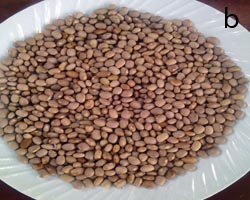 |
Plate 1. (a) Improved bean seeds (Lyamungu 90) and (b) Local bean seeds locally known as Mkanamna |
The experiments have four replicates of each treatment, which each plot measuring 5 m × 3.2 m. Under sole and intercrop, there were 85 maize plants/plot equivalent to 41,666 maize plants/ha. Under sole and intercrop there were 4 and 9 rows with 459 and 204 bean plants/plot, respectively, and this planting spacing constitutes an equivalent population of 250,000 bean plants/ha. The intercropping of maize/bean in the experimental plots was simultaneously additive (1/1), which is the common practice of farmers in the district (Plate 2).
 |
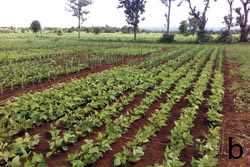 |
Plate 2. Appearance of (a) Intercropped bean and (b) Sole bean as on 19th April 2015 (At 23 days of age) in the Lower Zone |
The following describes the experiment in the Lower Zone. Two months after sowing, the plants were well established and covered most of the land with their canopy (Plate 3). The data collected were emergence (%), weekly ground coverage (%) and plant height, nodulation (number and colour), total harvest weight, stover weight, number of pods per plant, number of grains per pod and weight of 100-seeds (data not presented in this document).
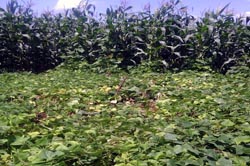 |
 |
Plate 3. Appearance of maize and bean plants as on 26th May 2015 (At 30 days of age) in the Lower Zone |
The bean variety Lyamungu 90 flowered 30 days after sowing. The local beans flowered 15 days later and concurrently formed the pods, hence escaped the risks of flower abortion due to shortfall of rain. All bean plants were ready for harvest by 26th June 2015 (Plate 4a,b) but harvesting was done on 4th July 2015 (Plate 4c) and some of the seeds kept (Plate 4d).
|
Plate 4. Bean plants at their last stages of being in the field and harvest in the Lower Zone: (a) 26th June 2015: Lyamungu 90 bean ready for harvest, (b) 26th June 2015: Local bean ready for harvest, |
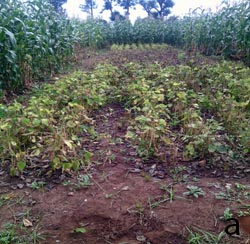 |
 |
| (c) 4th July 2015: Harvesting and data collection (bean) and (d) Local and Lyamungu 90 bean seeds | 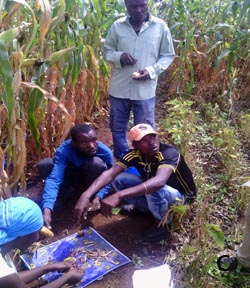 |
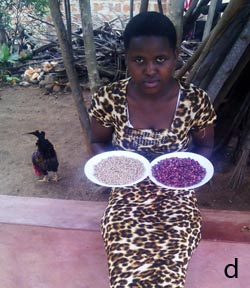 |
Eliakira Kisetu Nassary, Wageningen University, The Netherlands

